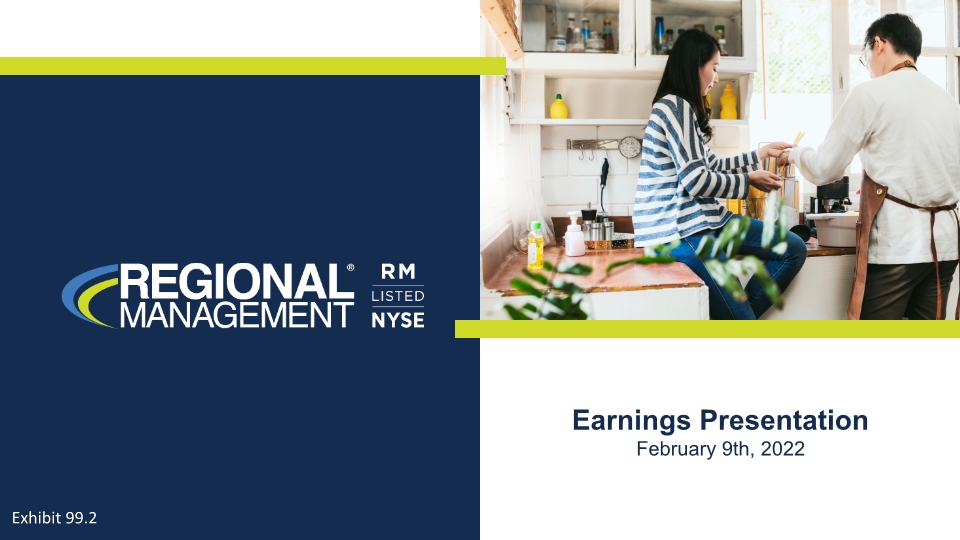
Earnings Presentation February 9th, 2022 Exhibit 99.2
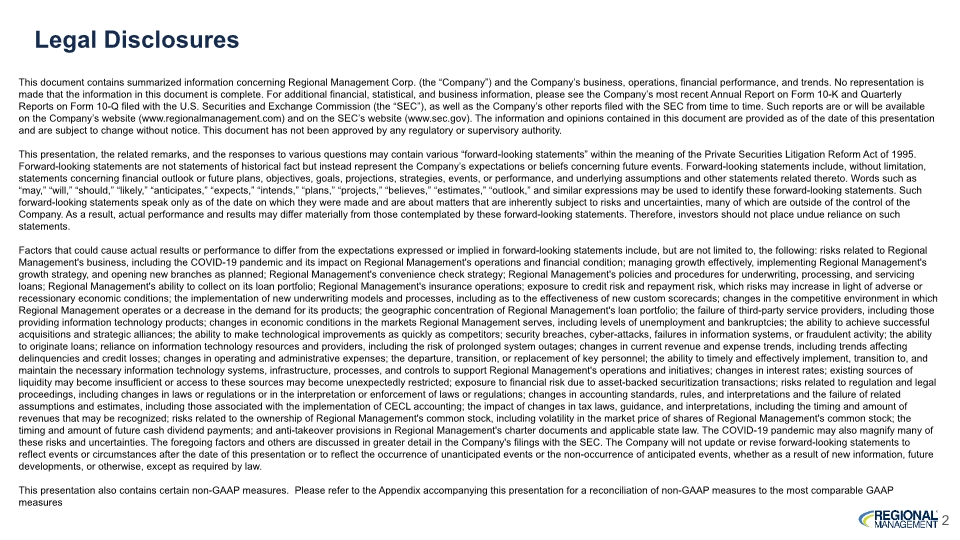
Legal Disclosures This document contains summarized information concerning Regional Management Corp. (the “Company”) and the Company’s business, operations, financial performance, and trends. No representation is made that the information in this document is complete. For additional financial, statistical, and business information, please see the Company’s most recent Annual Report on Form 10-K and Quarterly Reports on Form 10-Q filed with the U.S. Securities and Exchange Commission (the “SEC”), as well as the Company’s other reports filed with the SEC from time to time. Such reports are or will be available on the Company’s website (www.regionalmanagement.com) and on the SEC’s website (www.sec.gov). The information and opinions contained in this document are provided as of the date of this presentation and are subject to change without notice. This document has not been approved by any regulatory or supervisory authority. This presentation, the related remarks, and the responses to various questions may contain various “forward-looking statements” within the meaning of the Private Securities Litigation Reform Act of 1995. Forward-looking statements are not statements of historical fact but instead represent the Company’s expectations or beliefs concerning future events. Forward-looking statements include, without limitation, statements concerning financial outlook or future plans, objectives, goals, projections, strategies, events, or performance, and underlying assumptions and other statements related thereto. Words such as “may,” “will,” “should,” “likely,” “anticipates,” “expects,” “intends,” “plans,” “projects,” “believes,” “estimates,” “outlook,” and similar expressions may be used to identify these forward-looking statements. Such forward-looking statements speak only as of the date on which they were made and are about matters that are inherently subject to risks and uncertainties, many of which are outside of the control of the Company. As a result, actual performance and results may differ materially from those contemplated by these forward-looking statements. Therefore, investors should not place undue reliance on such statements. Factors that could cause actual results or performance to differ from the expectations expressed or implied in forward-looking statements include, but are not limited to, the following: risks related to Regional Management's business, including the COVID-19 pandemic and its impact on Regional Management's operations and financial condition; managing growth effectively, implementing Regional Management's growth strategy, and opening new branches as planned; Regional Management's convenience check strategy; Regional Management's policies and procedures for underwriting, processing, and servicing loans; Regional Management's ability to collect on its loan portfolio; Regional Management's insurance operations; exposure to credit risk and repayment risk, which risks may increase in light of adverse or recessionary economic conditions; the implementation of new underwriting models and processes, including as to the effectiveness of new custom scorecards; changes in the competitive environment in which Regional Management operates or a decrease in the demand for its products; the geographic concentration of Regional Management's loan portfolio; the failure of third-party service providers, including those providing information technology products; changes in economic conditions in the markets Regional Management serves, including levels of unemployment and bankruptcies; the ability to achieve successful acquisitions and strategic alliances; the ability to make technological improvements as quickly as competitors; security breaches, cyber-attacks, failures in information systems, or fraudulent activity; the ability to originate loans; reliance on information technology resources and providers, including the risk of prolonged system outages; changes in current revenue and expense trends, including trends affecting delinquencies and credit losses; changes in operating and administrative expenses; the departure, transition, or replacement of key personnel; the ability to timely and effectively implement, transition to, and maintain the necessary information technology systems, infrastructure, processes, and controls to support Regional Management's operations and initiatives; changes in interest rates; existing sources of liquidity may become insufficient or access to these sources may become unexpectedly restricted; exposure to financial risk due to asset-backed securitization transactions; risks related to regulation and legal proceedings, including changes in laws or regulations or in the interpretation or enforcement of laws or regulations; changes in accounting standards, rules, and interpretations and the failure of related assumptions and estimates, including those associated with the implementation of CECL accounting; the impact of changes in tax laws, guidance, and interpretations, including the timing and amount of revenues that may be recognized; risks related to the ownership of Regional Management's common stock, including volatility in the market price of shares of Regional Management's common stock; the timing and amount of future cash dividend payments; and anti-takeover provisions in Regional Management's charter documents and applicable state law. The COVID-19 pandemic may also magnify many of these risks and uncertainties. The foregoing factors and others are discussed in greater detail in the Company's filings with the SEC. The Company will not update or revise forward-looking statements to reflect events or circumstances after the date of this presentation or to reflect the occurrence of unanticipated events or the non-occurrence of anticipated events, whether as a result of new information, future developments, or otherwise, except as required by law. This presentation also contains certain non-GAAP measures. Please refer to the Appendix accompanying this presentation for a reconciliation of non-GAAP measures to the most comparable GAAP measures 2
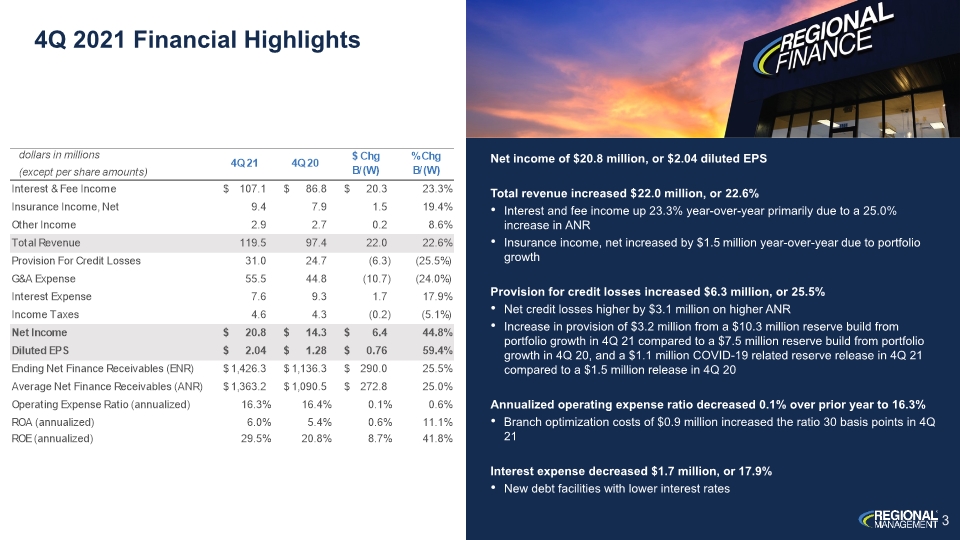
4Q 2021 Financial Highlights Net income of $20.8 million, or $2.04 diluted EPS Total revenue increased $22.0 million, or 22.6% Interest and fee income up 23.3% year-over-year primarily due to a 25.0% increase in ANR Insurance income, net increased by $1.5 million year-over-year due to portfolio growth Provision for credit losses increased $6.3 million, or 25.5% Net credit losses higher by $3.1 million on higher ANR Increase in provision of $3.2 million from a $10.3 million reserve build from portfolio growth in 4Q 21 compared to a $7.5 million reserve build from portfolio growth in 4Q 20, and a $1.1 million COVID-19 related reserve release in 4Q 21 compared to a $1.5 million release in 4Q 20 Annualized operating expense ratio decreased 0.1% over prior year to 16.3% Branch optimization costs of $0.9 million increased the ratio 30 basis points in 4Q 21 Interest expense decreased $1.7 million, or 17.9% New debt facilities with lower interest rates 3
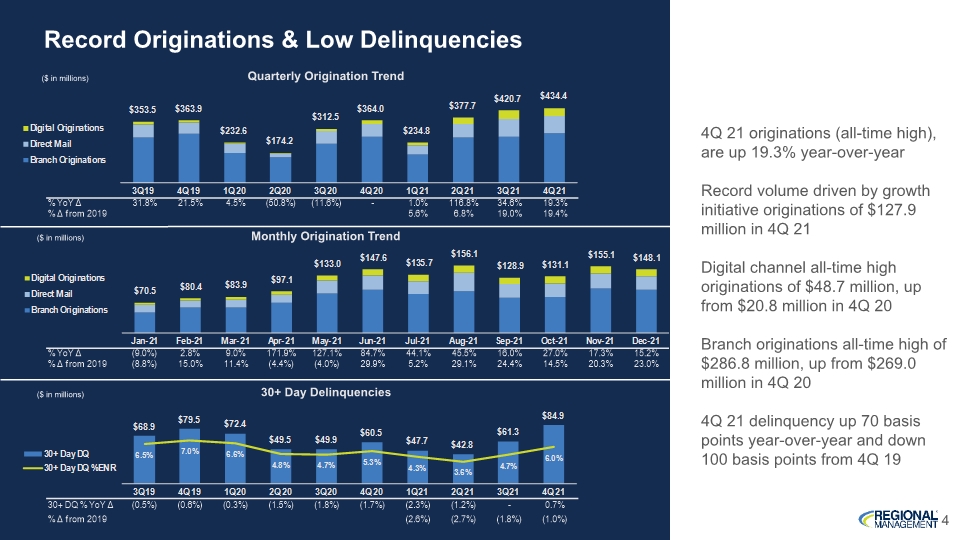
4Q 21 originations (all-time high), are up 19.3% year-over-year Record volume driven by growth initiative originations of $127.9 million in 4Q 21 Digital channel all-time high originations of $48.7 million, up from $20.8 million in 4Q 20 Branch originations all-time high of $286.8 million, up from $269.0 million in 4Q 20 4Q 21 delinquency up 70 basis points year-over-year and down 100 basis points from 4Q 19 Quarterly Origination Trend Monthly Origination Trend 30+ Day Delinquencies Record Originations & Low Delinquencies 4 ($ in millions) ($ in millions) ($ in millions)
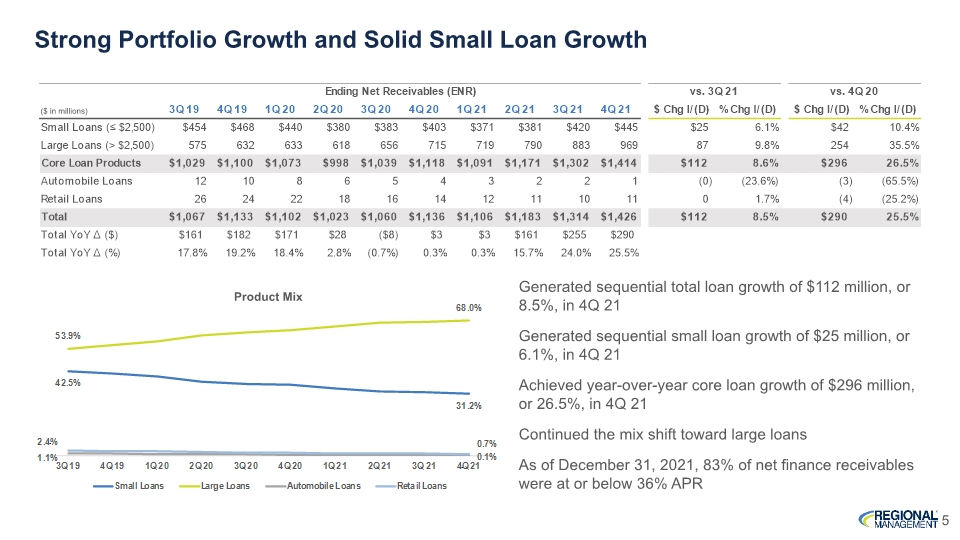
Strong Portfolio Growth and Solid Small Loan Growth Generated sequential total loan growth of $112 million, or 8.5%, in 4Q 21 Generated sequential small loan growth of $25 million, or 6.1%, in 4Q 21 Achieved year-over-year core loan growth of $296 million, or 26.5%, in 4Q 21 Continued the mix shift toward large loans As of December 31, 2021, 83% of net finance receivables were at or below 36% APR Product Mix 5 ($ in millions)
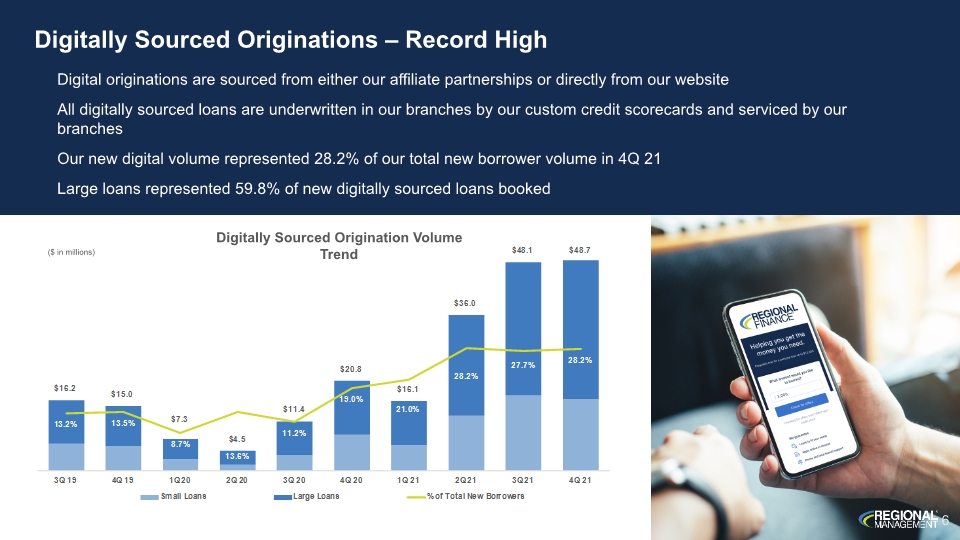
Digitally Sourced Originations – Record High Digital originations are sourced from either our affiliate partnerships or directly from our website All digitally sourced loans are underwritten in our branches by our custom credit scorecards and serviced by our branches Our new digital volume represented 28.2% of our total new borrower volume in 4Q 21 Large loans represented 59.8% of new digitally sourced loans booked Digitally Sourced Origination Volume Trend 6 ($ in millions)
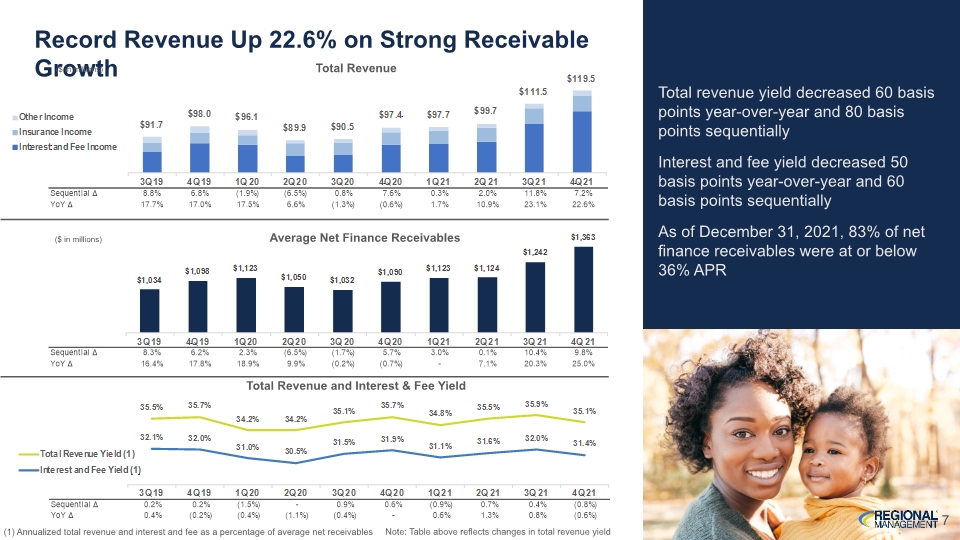
Record Revenue Up 22.6% on Strong Receivable Growth (1) Annualized total revenue and interest and fee as a percentage of average net receivables Total revenue yield decreased 60 basis points year-over-year and 80 basis points sequentially Interest and fee yield decreased 50 basis points year-over-year and 60 basis points sequentially As of December 31, 2021, 83% of net finance receivables were at or below 36% APR Total Revenue Average Net Finance Receivables Total Revenue and Interest & Fee Yield 7 ($ in millions) ($ in millions) Note: Table above reflects changes in total revenue yield
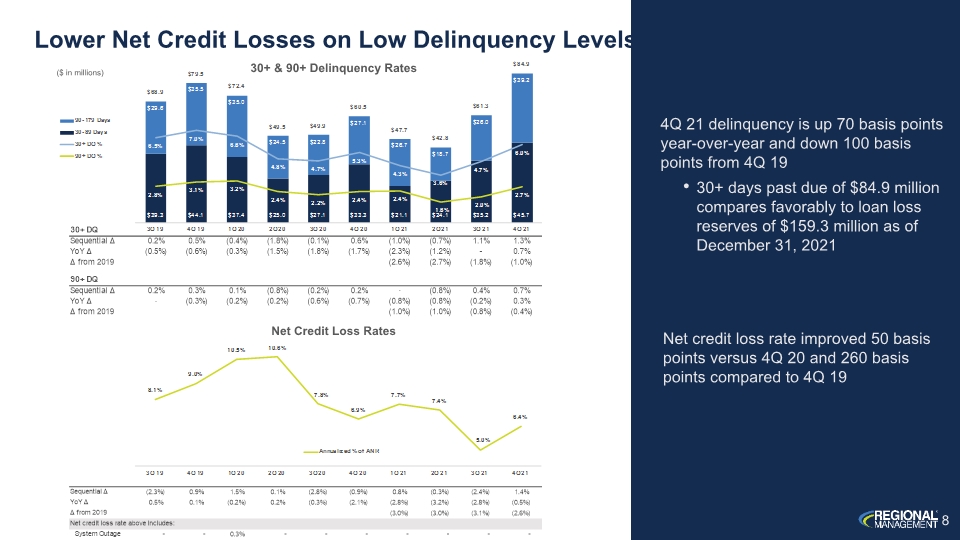
Lower Net Credit Losses on Low Delinquency Levels 4Q 21 delinquency is up 70 basis points year-over-year and down 100 basis points from 4Q 19 30+ days past due of $84.9 million compares favorably to loan loss reserves of $159.3 million as of December 31, 2021 Net credit loss rate improved 50 basis points versus 4Q 20 and 260 basis points compared to 4Q 19 30+ & 90+ Delinquency Rates Net Credit Loss Rates 8 ($ in millions)
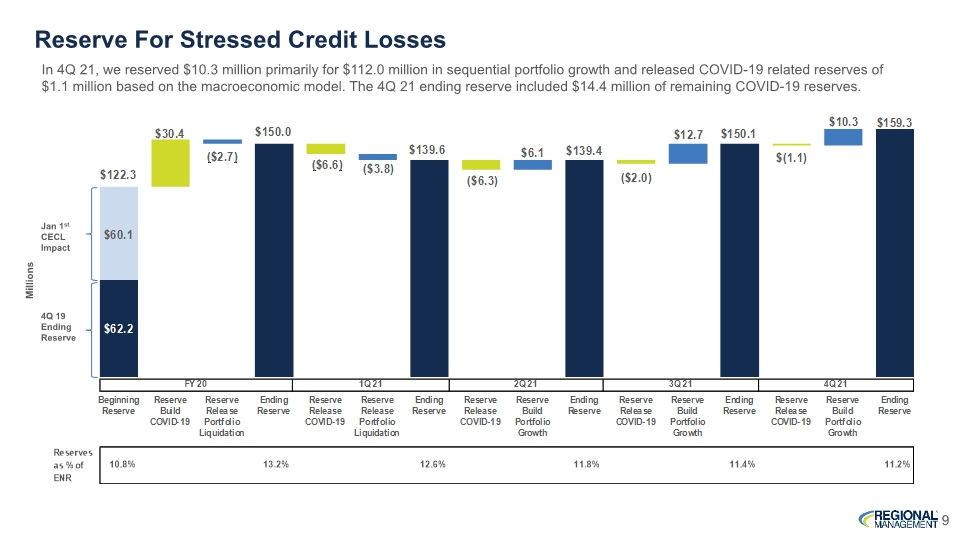
Reserve For Stressed Credit Losses In 4Q 21, we reserved $10.3 million primarily for $112.0 million in sequential portfolio growth and released COVID-19 related reserves of $1.1 million based on the macroeconomic model. The 4Q 21 ending reserve included $14.4 million of remaining COVID-19 reserves. 9 Millions Jan 1st CECL Impact 4Q 19 Ending Reserve
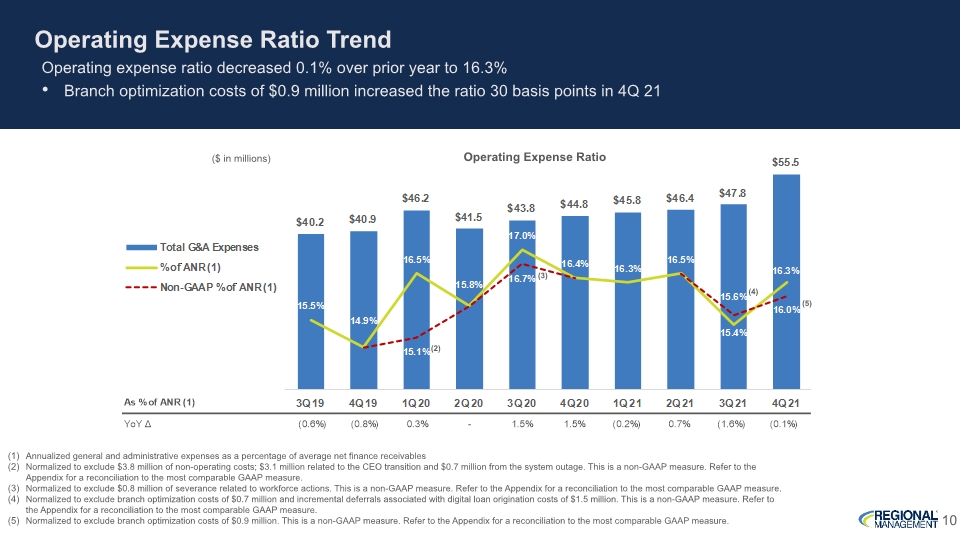
Operating Expense Ratio Trend Operating expense ratio decreased 0.1% over prior year to 16.3% Branch optimization costs of $0.9 million increased the ratio 30 basis points in 4Q 21 Annualized general and administrative expenses as a percentage of average net finance receivables Normalized to exclude $3.8 million of non-operating costs; $3.1 million related to the CEO transition and $0.7 million from the system outage. This is a non-GAAP measure. Refer to the Appendix for a reconciliation to the most comparable GAAP measure. Normalized to exclude $0.8 million of severance related to workforce actions. This is a non-GAAP measure. Refer to the Appendix for a reconciliation to the most comparable GAAP measure. Normalized to exclude branch optimization costs of $0.7 million and incremental deferrals associated with digital loan origination costs of $1.5 million. This is a non-GAAP measure. Refer to the Appendix for a reconciliation to the most comparable GAAP measure. Normalized to exclude branch optimization costs of $0.9 million. This is a non-GAAP measure. Refer to the Appendix for a reconciliation to the most comparable GAAP measure. Operating Expense Ratio 10 ($ in millions) (2) (3) (4) (5)
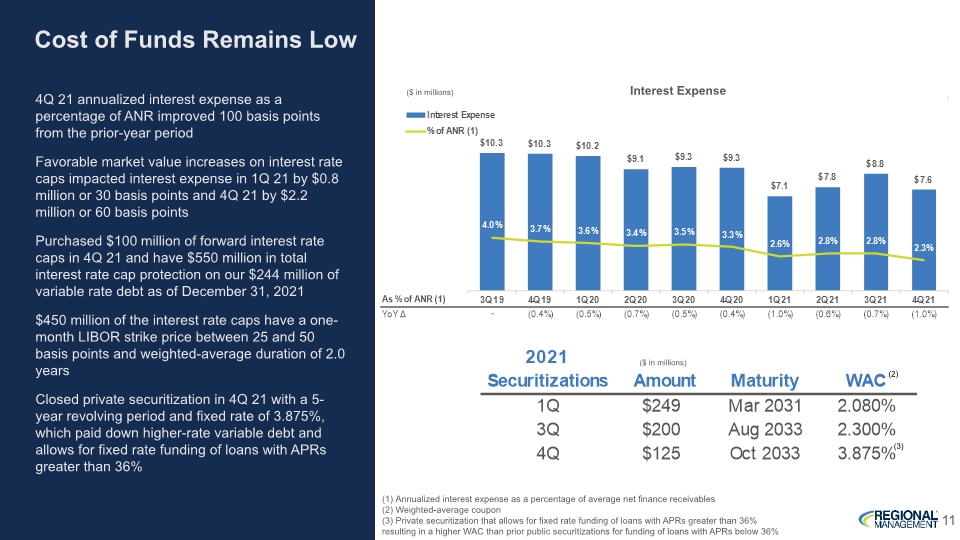
Cost of Funds Remains Low 4Q 21 annualized interest expense as a percentage of ANR improved 100 basis points from the prior-year period Favorable market value increases on interest rate caps impacted interest expense in 1Q 21 by $0.8 million or 30 basis points and 4Q 21 by $2.2 million or 60 basis points Purchased $100 million of forward interest rate caps in 4Q 21 and have $550 million in total interest rate cap protection on our $244 million of variable rate debt as of December 31, 2021 $450 million of the interest rate caps have a one- month LIBOR strike price between 25 and 50 basis points and weighted-average duration of 2.0 years Closed private securitization in 4Q 21 with a 5-year revolving period and fixed rate of 3.875%, which paid down higher-rate variable debt and allows for fixed rate funding of loans with APRs greater than 36% (1) Annualized interest expense as a percentage of average net finance receivables (2) Weighted-average coupon (3) Private securitization that allows for fixed rate funding of loans with APRs greater than 36% resulting in a higher WAC than prior public securitizations for funding of loans with APRs below 36% Interest Expense 11 ($ in millions) ($ in millions) (2) (3)
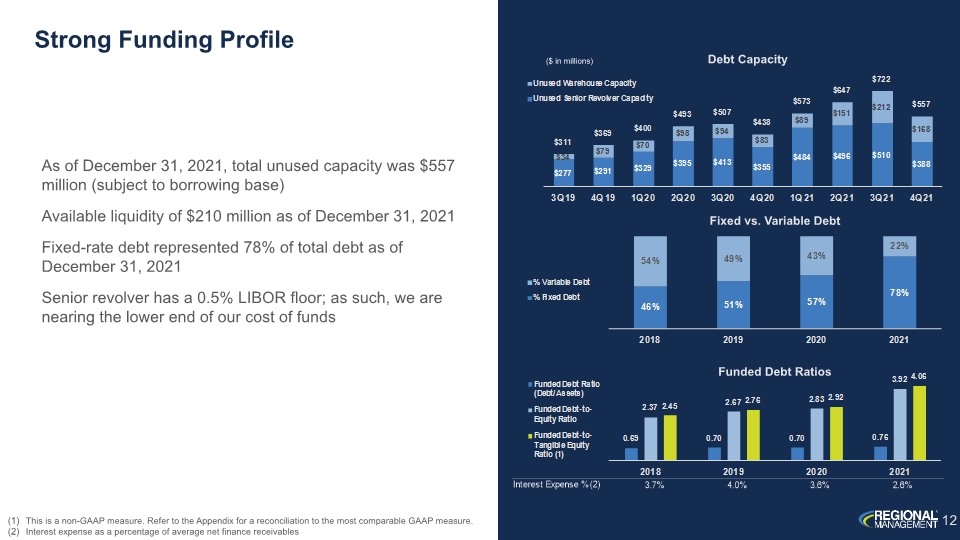
Strong Funding Profile As of December 31, 2021, total unused capacity was $557 million (subject to borrowing base) Available liquidity of $210 million as of December 31, 2021 Fixed-rate debt represented 78% of total debt as of December 31, 2021 Senior revolver has a 0.5% LIBOR floor; as such, we are nearing the lower end of our cost of funds Debt Capacity Fixed vs. Variable Debt Funded Debt Ratios 12 ($ in millions) This is a non-GAAP measure. Refer to the Appendix for a reconciliation to the most comparable GAAP measure. Interest expense as a percentage of average net finance receivables

Appendix 13
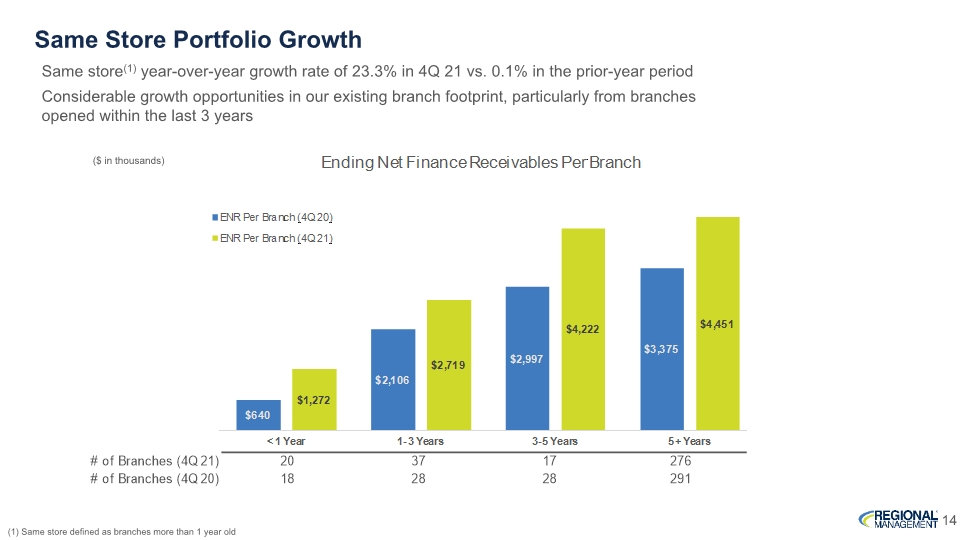
Same Store Portfolio Growth Same store(1) year-over-year growth rate of 23.3% in 4Q 21 vs. 0.1% in the prior-year period Considerable growth opportunities in our existing branch footprint, particularly from branches opened within the last 3 years (1) Same store defined as branches more than 1 year old 14 ($ in thousands)
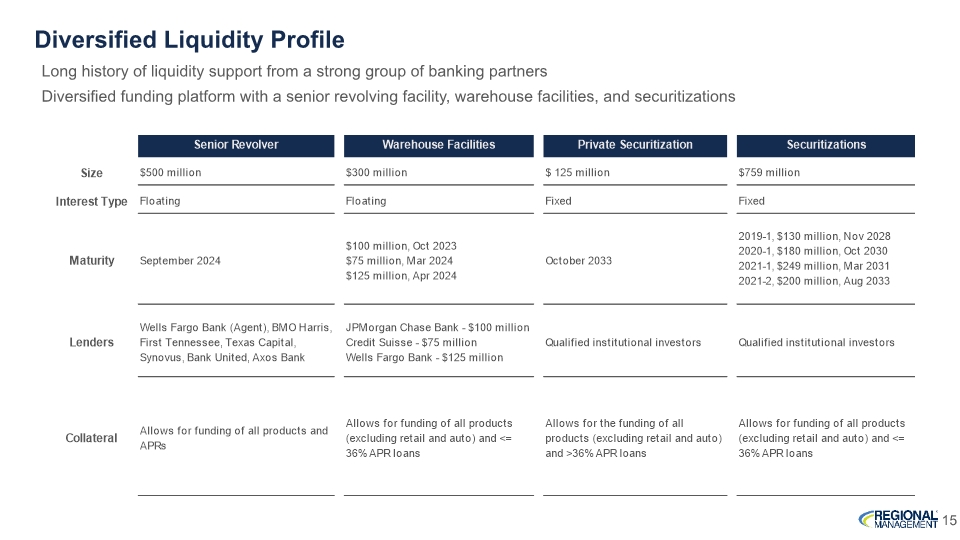
Diversified Liquidity Profile Long history of liquidity support from a strong group of banking partners Diversified funding platform with a senior revolving facility, warehouse facilities, and securitizations 15
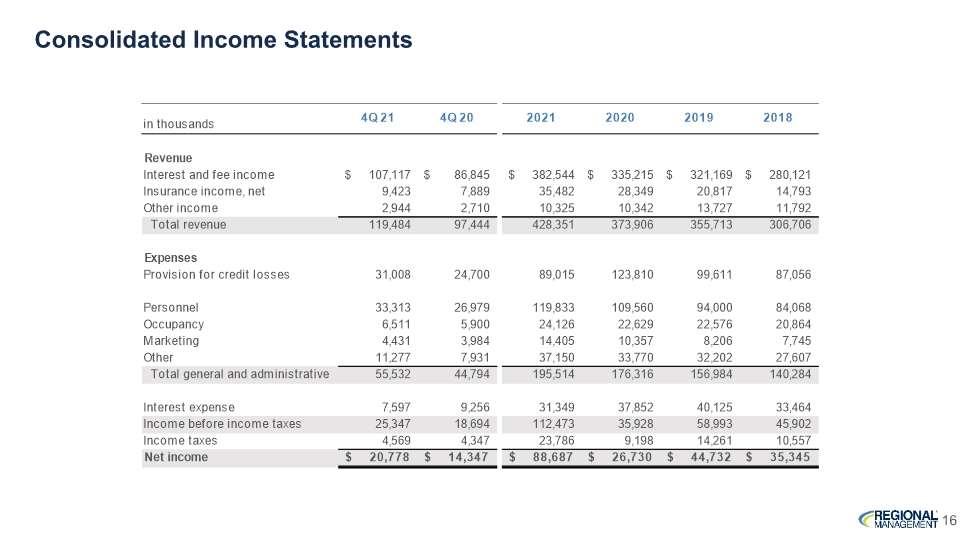
Consolidated Income Statements 16
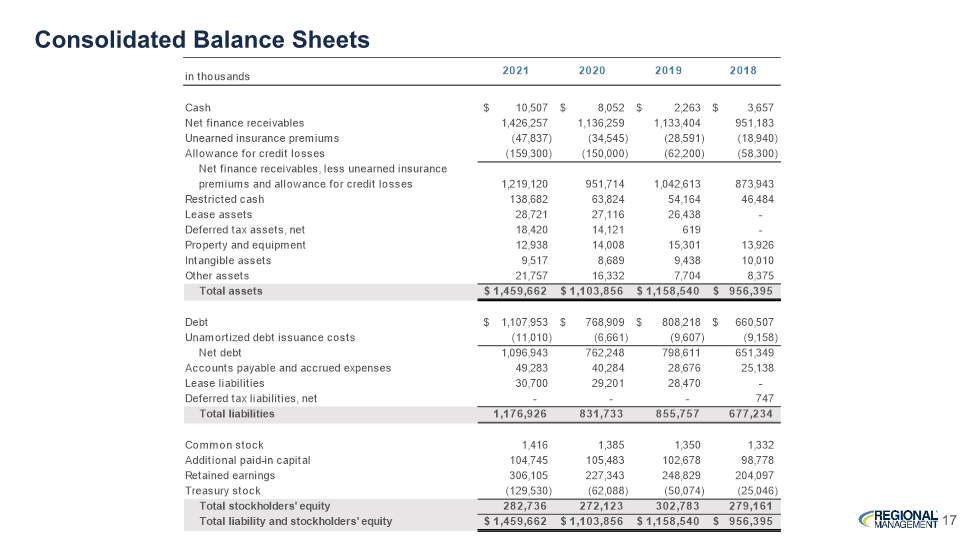
Consolidated Balance Sheets 17
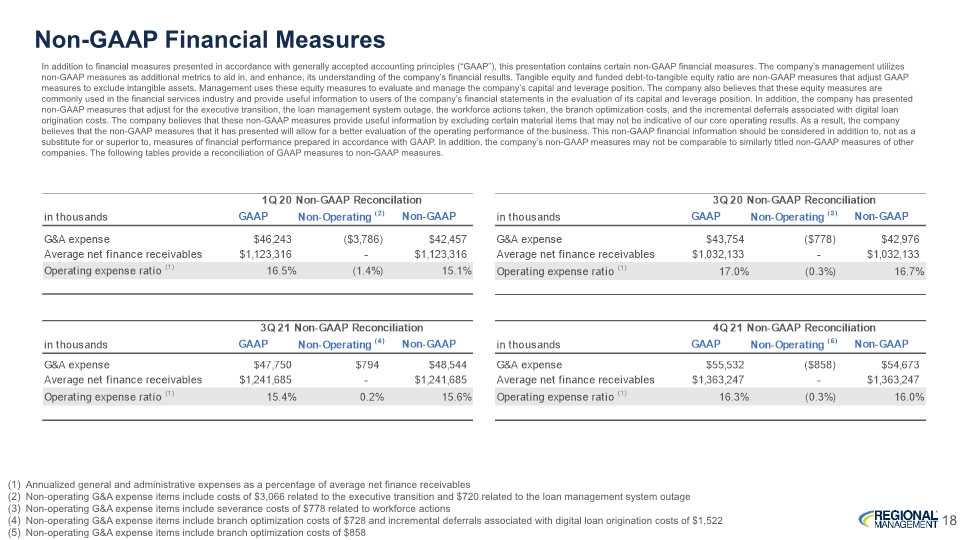
Non-GAAP Financial Measures In addition to financial measures presented in accordance with generally accepted accounting principles (“GAAP”), this presentation contains certain non-GAAP financial measures. The company’s management utilizes non-GAAP measures as additional metrics to aid in, and enhance, its understanding of the company’s financial results. Tangible equity and funded debt-to-tangible equity ratio are non-GAAP measures that adjust GAAP measures to exclude intangible assets. Management uses these equity measures to evaluate and manage the company’s capital and leverage position. The company also believes that these equity measures are commonly used in the financial services industry and provide useful information to users of the company’s financial statements in the evaluation of its capital and leverage position. In addition, the company has presented non-GAAP measures that adjust for the executive transition, the loan management system outage, the workforce actions taken, the branch optimization costs, and the incremental deferrals associated with digital loan origination costs. The company believes that these non-GAAP measures provide useful information by excluding certain material items that may not be indicative of our core operating results. As a result, the company believes that the non-GAAP measures that it has presented will allow for a better evaluation of the operating performance of the business. This non-GAAP financial information should be considered in addition to, not as a substitute for or superior to, measures of financial performance prepared in accordance with GAAP. In addition, the company’s non-GAAP measures may not be comparable to similarly titled non-GAAP measures of other companies. The following tables provide a reconciliation of GAAP measures to non-GAAP measures. Annualized general and administrative expenses as a percentage of average net finance receivables Non-operating G&A expense items include costs of $3,066 related to the executive transition and $720 related to the loan management system outage Non-operating G&A expense items include severance costs of $778 related to workforce actions Non-operating G&A expense items include branch optimization costs of $728 and incremental deferrals associated with digital loan origination costs of $1,522 Non-operating G&A expense items include branch optimization costs of $858 18
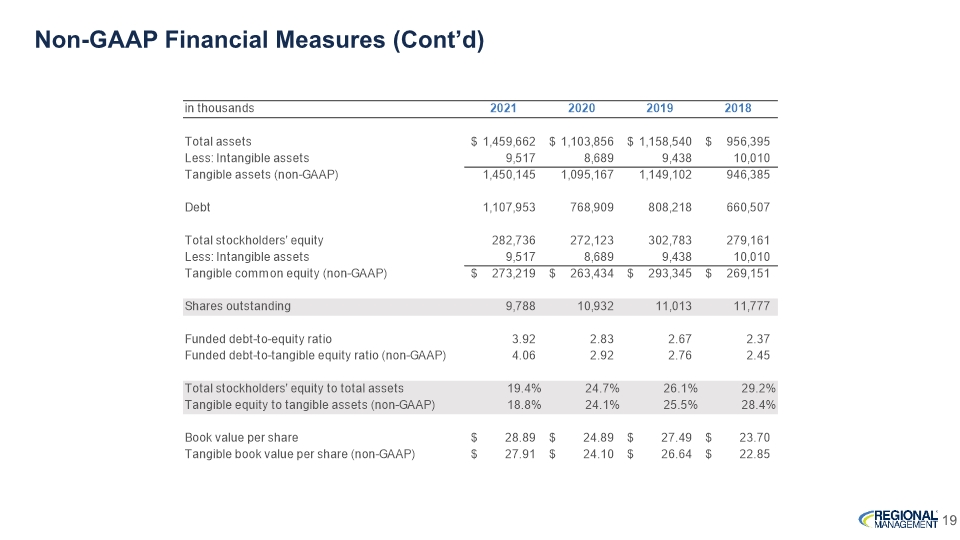
Non-GAAP Financial Measures (Cont’d) 19


















